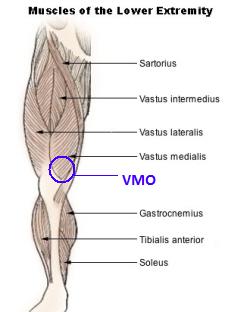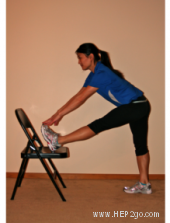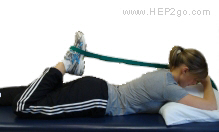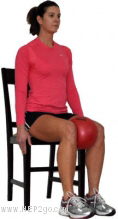for Patellar Maltracking
Knee cap exercises can be really helpful in reducing knee pain. They strengthen the VMO muscles (Vastus Medialis Oblique) around the patella improving how the kneecap moves.
The VMO muscles are part of the quadriceps muscles and are found on the inner side of the knee. Their job is to control the kneecap movement, known as patellar tracking. They hold the kneecap in the middle of the patellar groove so it glides smoothly during any leg movement.
If the kneecap muscles are weak, the kneecap shifts slightly to the outer side of the knee. This prevents it from moving properly, known as patellar maltracking, which leads to pain and irritation. Knee cap pain is common and is often caused by conditions such as Runners Knee and Chondromalacia Patella.
Why Do Knee Cap Exercises?
The VMO muscles should be working the whole time when the knee moves, but if there is knee pain or there has been a kneecap injury such as a dislocation, they often switch off and stop working properly. Regular quads strengthening exercises e.g. squats and lunges, don’t specifically target the VMO muscles. They need to be strengthened in a slightly different way.
Here you will find some easy to perform yet effective knee cap exercises for the VMO muscles. They will improve your patellar tracking and the stability of your knee.
Finding the Knee Cap Muscles

Before you can strengthen the knee cap muscles, you need to know how to make sure they are working.
Sit comfortably in a chair and put your fingers at the top of your kneecap. Move your fingers up an inch, and inwards an inch so you are on a soft fleshy bit – this is the VMO. Push your knee and foot down into the floor and you should feel the muscle tighten/clench under your fingers.
It might take a few goes before you feel this – keep practising. When you are doing any of the knee cap exercises below, keep checking that you can feel the VMO muscles working.
Knee Cap Exercises
Once you are happy that your VMO muscles are working, you can start doing these exercises. Get the hang of stages 1 and 2 before moving on to stage 3.
1) VMO Stage 1
Starting Position: Sit in a chair, feet hip width apart with a soft football in between your knees
Action: Clench your buttocks, clench your knees and gently squeeze the ball with your knees. Hold for 3-5 secs and relax
Repetition: Repeat 10-20x, 2x daily
Tips: 1) Feel for the VMO muscle tightening with your fingers
2) When you squeeze the ball, make sure the squeezing movement comes from your knees, not your hips
2) When you squeeze the ball, make sure the squeezing movement comes from your knees, not your hips
2) VMO Stage 2
Starting Position: Lying on your back with a pillow under your knees so knees are bent 30°. Feet hip width apart with a soft football in between your knees
Action: Squeeze the football as with stage 1 ex (clench buttocks and knee muscles) and then lift the foot of the weak leg up off the bed, straightening the knee. Hold for 3 secs, slowly lower the leg and finally relax the knee.
Repetition: Repeat 10-20x, 2x daily
Note: Ensure that you keep squeezing the ball throughout the exercise – keep the knee and buttock clench going throughout.
2) Keep the knee resting on the pillow – do not lift it up
2) Keep the knee resting on the pillow – do not lift it up
3) VMO Stage 3
Starting Position: Stand with your back against the wall, feet hip width apart about 10cm away from the wall. Place a soft football in between your knees
Action: Squeeze the ball as with stage 1 & 2 (clench knees and buttocks) and then slowly squat down as far as comfortable. Hold for 3 secs and come back up
Repetition: Repeat 10-20x, 2x daily
Progression: Progress the exercise by gradually increasing the depth of the squat but take care not to aggravate your knee pain.
Stretches
How Can I Tell if my Muscles are Tight?

The best way to tell if muscle tightness is causing or contributing to your pain is to see a physical therapist who can fully assess you. However there are some simple tests you can try at home that will give you an indication of any tightness.
Are My Hamstrings Tight?
1) Simplest – When standing, try and touch your toes whilst keeping your knee straight. If you can, you probably don’t have tight hamstrings, if you can’t then you probably need Hamstring stretches
2) More specific – Lie on your back and lift your leg up so your hip is bent 90°. Then, keeping your hip still, raise your foot and straighten your knee as much as you can. A woman should be able to get her knee within 20° of fully straight, and a man within 30°. If you can’t get your knee that straight, you most likely have tight hamstrings
Are My Quads Tight?
1) Simplest – lie on your tummy on a firm surface. Bring your heel towards your bottom. If you can touch your bottom with your foot (or nearly can) your quads are probably fine. If you can’t, they are probably tight and would benefit from Quads stretches
2) More specific – Sit on the bottom edge of a bed. Hug your good knee into your chest, leaving your other leg relaxed. Slowly lean backwards until you are lying down on your back (still hugging your good leg). Let your free leg relax and hang down off the bed and see how much the knee bends (without you pushing it). If it bends less than 90° (a right angle), you probably have tight quads
Getting the Best Results
This is a case where it really is "no pain, no gain". Stretching effectively should be moderately uncomfortable (i.e. slightly unpleasant!) when you do it, but only in the muscle being stretched and the pain should stop as soon as you stop stretching.
If you feel nothing or only slight discomfort when stretching, the exercise will likely not be very effective – you need to push it a bit further. However, if you have damaged a muscle e.g. hamstring tear, you should NOT start stretching too early – wait until you can use the muscle without pain before starting knee stretches.
How Much Should I Stretch?

There has been lots of research into the most effective way to stretch i.e. the minimum effort for the maximum benefit and the conclusion is:
• Hold the stretch for 30 seconds
• Repeat the stretch 3 times
• Do the exercise 1-2 times daily
• Repeat the stretch 3 times
• Do the exercise 1-2 times daily
How Do I Do Knee Stretches?
To find out how to do knee stretches for different muscles, choose from the links below:
1) Quads Stretches: for tight muscles at the front of your thigh
2) Hamstring Stretches: to stretch the muscles on the back of your thigh
3) Calf Stretches: for the muscles on the back of your lower leg
4) Glutes Stretches: to stretch you buttock muscles
5) ITB Stretches: stretch the iliotibial band on the outside of your leg from hip to knee
2) Hamstring Stretches: to stretch the muscles on the back of your thigh
3) Calf Stretches: for the muscles on the back of your lower leg
4) Glutes Stretches: to stretch you buttock muscles
5) ITB Stretches: stretch the iliotibial band on the outside of your leg from hip to knee
Stretching exercises have been proven to help decrease knee pain and reduce the chance of injury.

Nenhum comentário:
Postar um comentário